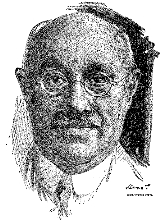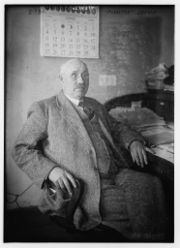
William E. Johnson
Encyclopedia
William Eugene "Pussyfoot" Johnson (25 March 1862 – 2 February 1945) was an American
Prohibition
advocate and law enforcement officer. In pursuit of his campaign to outlaw intoxicating beverages, he openly admitted to drinking liquor, bribery, and lying. He gained the nickname "Pussyfoot" due to his cat-like stealth in the pursuit of suspects in the Oklahoma Territory
.
, Johnson was educated at the University of Nebraska. Following college, he stayed in Lincoln, Nebraska
and worked at The Lincoln Daily News before becoming manager of the Nebraska News Bureau. He met Lillie M. Trevitt while in Lincoln and the two were married in 1886. Johnson's first wife died in 1927 and he married May B. Stanley of Washington D.C. in 1928.
During his time in Nebraska, Johnson's views on temperance were formed and he gained a reputation as a Prohibitionist. In 1889, while Nebraska was engaged in a debate over state-wide prohibition, Johnson posed as an anti-Prohibitionist to obtain information from brewery and saloon owners. He then published information which was detrimental to the "wet" cause.
Johnson's temperance activities earned him governmental notice and he was appointed special agent of the Department of the Interior
to enforce laws in Indian Territory and Oklahoma in 1906. He was chief agent of the United States Indian Service from July 1908 until September 1911 and secured more than 4,400 convictions through a practice of sweeping into gambling saloons and other disorderly places. Saloon keepers affected by Johnson's raids banded together to offer a US$3,000 reward for his death. Upon learning of the reward, Johnson changed to nighttime raids and destroyed most of the raided establishments.
 After resigning from federal service, he moved to Kansas
After resigning from federal service, he moved to Kansas
and began working with the Anti-Saloon League
. There "he developed some of the tactics that would later be widely used in the Anti-Saloon League. For example, he wrote to wet leaders falsely claiming to be a brewer and asked for advice on how to defeat temperance activists. He then published the letters he received to embarrass and discredit his opposition."
Johnson served as managing editor of 35 Anti-Saloon League publications between 1912 and 1926 before becoming manager and then director of the London office of the World League Against Alcoholism
. He was a member of the International Temperance Committee of Fifty in Paris
(1919) and was also a delegate to the fourteenth International Anti-Alcoholic Congress in Milan
(1913) and Tartu
(1926).
In addition to his work within the United States, Johnson toured internationally to promote Prohibition. On 13 November 1919, he was captured by a mob of medical students while at a speaking engagement at Essex Hall and paraded through the streets of London
on a stretcher before being rescued by police. During the ragging
, Johnson was struck by an object thrown from the crowd and lost his right eye after physicians were unable to repair the resulting damage. In April 1921, Johnson was booed into silence at Toronto's Massey Hall
and at a rally in downtown Windsor while campaigning for tightening of Ontario's prohibition laws. The big Windsor crowd -- in a city at the hub of "rumrunner" smuggling -- was so hostile that Johnson had to be surrounded by police and escorted to Detroit.
Johnson retired from public life in 1930, returning to his family farm in Chenango County, New York
until his death on 2 February 1945.
United States
The United States of America is a federal constitutional republic comprising fifty states and a federal district...
Prohibition
Prohibition
Prohibition of alcohol, often referred to simply as prohibition, is the practice of prohibiting the manufacture, transportation, import, export, sale, and consumption of alcohol and alcoholic beverages. The term can also apply to the periods in the histories of the countries during which the...
advocate and law enforcement officer. In pursuit of his campaign to outlaw intoxicating beverages, he openly admitted to drinking liquor, bribery, and lying. He gained the nickname "Pussyfoot" due to his cat-like stealth in the pursuit of suspects in the Oklahoma Territory
Oklahoma Territory
The Territory of Oklahoma was an organized incorporated territory of the United States that existed from May 2, 1890, until November 16, 1907, when it was joined with the Indian Territory under a new constitution and admitted to the Union as the State of Oklahoma.-Organization:Oklahoma Territory's...
.
Biography
Born in Coventry, New YorkCoventry, New York
Coventry is a town in Chenango County, New York, United States. The population was 1,589 at the 2000 census. The town is named after Coventry, Connecticut by settlers from New England....
, Johnson was educated at the University of Nebraska. Following college, he stayed in Lincoln, Nebraska
Lincoln, Nebraska
The City of Lincoln is the capital and the second-most populous city of the US state of Nebraska. Lincoln is also the county seat of Lancaster County and the home of the University of Nebraska. Lincoln's 2010 Census population was 258,379....
and worked at The Lincoln Daily News before becoming manager of the Nebraska News Bureau. He met Lillie M. Trevitt while in Lincoln and the two were married in 1886. Johnson's first wife died in 1927 and he married May B. Stanley of Washington D.C. in 1928.
During his time in Nebraska, Johnson's views on temperance were formed and he gained a reputation as a Prohibitionist. In 1889, while Nebraska was engaged in a debate over state-wide prohibition, Johnson posed as an anti-Prohibitionist to obtain information from brewery and saloon owners. He then published information which was detrimental to the "wet" cause.
Johnson's temperance activities earned him governmental notice and he was appointed special agent of the Department of the Interior
United States Department of the Interior
The United States Department of the Interior is the United States federal executive department of the U.S. government responsible for the management and conservation of most federal land and natural resources, and the administration of programs relating to Native Americans, Alaska Natives, Native...
to enforce laws in Indian Territory and Oklahoma in 1906. He was chief agent of the United States Indian Service from July 1908 until September 1911 and secured more than 4,400 convictions through a practice of sweeping into gambling saloons and other disorderly places. Saloon keepers affected by Johnson's raids banded together to offer a US$3,000 reward for his death. Upon learning of the reward, Johnson changed to nighttime raids and destroyed most of the raided establishments.

Kansas
Kansas is a US state located in the Midwestern United States. It is named after the Kansas River which flows through it, which in turn was named after the Kansa Native American tribe, which inhabited the area. The tribe's name is often said to mean "people of the wind" or "people of the south...
and began working with the Anti-Saloon League
Anti-Saloon League
The Anti-Saloon League was the leading organization lobbying for prohibition in the United States in the early 20th century. It was a key component of the Progressive Era, and was strongest in the South and rural North, drawing heavy support from pietistic Protestant ministers and their...
. There "he developed some of the tactics that would later be widely used in the Anti-Saloon League. For example, he wrote to wet leaders falsely claiming to be a brewer and asked for advice on how to defeat temperance activists. He then published the letters he received to embarrass and discredit his opposition."
Johnson served as managing editor of 35 Anti-Saloon League publications between 1912 and 1926 before becoming manager and then director of the London office of the World League Against Alcoholism
World League Against Alcoholism
thumb|right|300px|The Drunkard's Progress: A lithograph by [[Nathaniel Currier]] supporting the temperance movement, January 1846.The World League Against Alcoholism was organized by the Anti-Saloon League, whose goal became establishing prohibition not only in the United States but throughout the...
. He was a member of the International Temperance Committee of Fifty in Paris
Paris
Paris is the capital and largest city in France, situated on the river Seine, in northern France, at the heart of the Île-de-France region...
(1919) and was also a delegate to the fourteenth International Anti-Alcoholic Congress in Milan
Milan
Milan is the second-largest city in Italy and the capital city of the region of Lombardy and of the province of Milan. The city proper has a population of about 1.3 million, while its urban area, roughly coinciding with its administrative province and the bordering Province of Monza and Brianza ,...
(1913) and Tartu
Tartu
Tartu is the second largest city of Estonia. In contrast to Estonia's political and financial capital Tallinn, Tartu is often considered the intellectual and cultural hub, especially since it is home to Estonia's oldest and most renowned university. Situated 186 km southeast of Tallinn, the...
(1926).
In addition to his work within the United States, Johnson toured internationally to promote Prohibition. On 13 November 1919, he was captured by a mob of medical students while at a speaking engagement at Essex Hall and paraded through the streets of London
London
London is the capital city of :England and the :United Kingdom, the largest metropolitan area in the United Kingdom, and the largest urban zone in the European Union by most measures. Located on the River Thames, London has been a major settlement for two millennia, its history going back to its...
on a stretcher before being rescued by police. During the ragging
Ragging
Ragging is a practice in educational institutions in India, Pakistan and Sri Lanka that involves existing students baiting or bullying new students. It is similar to the American phenomenon of hazing. It often takes a malignant form wherein the newcomers may be subjected to psychological or...
, Johnson was struck by an object thrown from the crowd and lost his right eye after physicians were unable to repair the resulting damage. In April 1921, Johnson was booed into silence at Toronto's Massey Hall
Massey Hall
Massey Hall is a venerable performing arts theatre in the Garden District of downtown Toronto. The theatre originally was designed to seat 3,500 patrons but, after extensive renovations in the 1940s, now seats up to 2,765....
and at a rally in downtown Windsor while campaigning for tightening of Ontario's prohibition laws. The big Windsor crowd -- in a city at the hub of "rumrunner" smuggling -- was so hostile that Johnson had to be surrounded by police and escorted to Detroit.
Johnson retired from public life in 1930, returning to his family farm in Chenango County, New York
Chenango County, New York
Chenango County is a county located in the U.S. state of New York. As of the 2010 census, the population was 50,477. The county's name originates from an Oneida word meaning "large bull-thistle." Its county seat is Norwich.-History:...
until his death on 2 February 1945.
External links
- Johnson, William E. from Nebraska State Historical Society
- William E. Johnson (Westerville Public Library)

